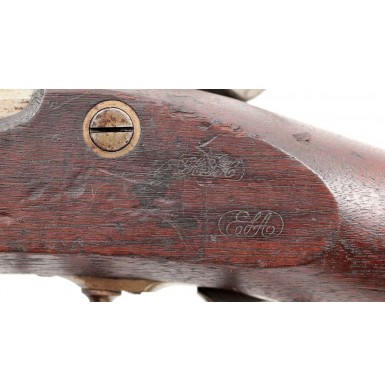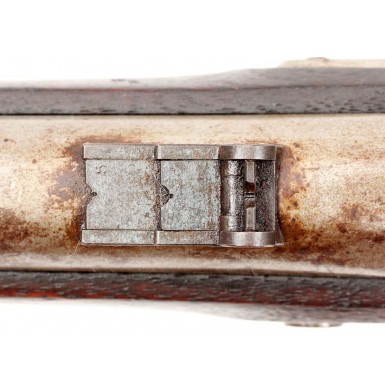1862 Dated M-1861 Springfield Rifle Musket
- Product Code: FLA-3030-SOLD
- Availability: Out Of Stock
-
$1.00
By the spring of 1860, the shortcomings of the Maynard patent automated priming system had been discovered by troops in the field. The system had been incorporated into the US M-1855 series of long arms, but constant problems with the primer tapes had made the guns unreliable. As a result, many field commanders were utilizing conventional percussion caps to avoid the problems associated with the primer tapes. In May of 1860 the US Ordnance Board was convened to assess the problems with the Maynard system and to explore potential solutions. The findings recommended that all future US arms dispense with the Maynard system and revert to the simpler conventional percussion ignition lock, which was very reliable and much cheaper to produce. The Secretary of War officially approved the recommendations from the Board of Ordnance on February 20, 1861. This was fortuitous, as in just a few weeks, the United States would be plunged into the American Civil War, and the Union would need every rifle musket that could be produced, and as quickly as possible. The newly authorized and improved version of the US M-1855 Rifle Musket was officially adopted as the US M-1861 Rifle Musket. The gun not only eliminated the Maynard priming system, but also made some minor improvements to the hammer and mainspring, and reduced the diameter of the ramrod head slightly, to make it easier to ram a cartridge in a fouled barrel. The changes in the lock necessitated changes in the mortise that was cut in the stock, and these were adopted as well. As initially accepted, the new M-1861 was to include a circular iron patchbox in the buttstock at the recommendation of Springfield’s Master Armorer Erskine S. Allin. However, the patchbox was eliminated as a means of speeding production once the war broke out, and was probably never included in more than a few sample guns. The final change for the M-1861 Rifle Musket was a new, improved rear sight that was developed by Elisha K. Root, the driving force behind many of Colt’s designs. Root had approached Allin in June of 1861 with some design ideas for the rifle musket that Colt wanted to produce for the US government. The gun was a sort of hybrid of Springfield and Enfield design features, and together Allin and Root supervised the manufacture of the first US M-1861 “Special Model” Rifle Musket at Springfield, which would become the sample used by the Colt production team. Root’s improvements to the M-1858 rear sight that had been used on late production M-1855 rifles and rifle muskets appear to be minor and cosmetic, but improved the functionality and stability of the sight. First, Root designed the sight base walls to be higher, which protected the 100 & 300-yard sight blades when they were laying flat. He also recessed the head of the screw that that the sight blades pivoted on, which protected the screw from damage. Finally he squared off the tops of the sight leaves and deepened the notches. This made the sight leaves easier to move and adjust with a fingernail and made the sight picture clearer. Allin was sufficiently impressed with these improvements that the M-1861 rear sight was adopted in July of 1861 and replaced the M-1858 rear sight on the M-1861 Rifle Musket. In all other ways, the M-1861 was essentially identical to the previous M-1855, with a .58 caliber, 40” round barrel, iron mountings, spring retained bands and walnut stock. After all of the changes were implemented and new tooling was put in place, production of the new US M-1861 Rifle Musket began at the Springfield Arsenal in July of 1861. Because the Harper’s Ferry Arsenal was captured by Virginia state troops in April of 1861, and the machinery removed to Richmond and Fayetteville, no M-1861 muskets were ever produced at that facility. Springfield produced some 11,102 M-1861s during the 3rd quarter of 1861 and doubled that output to 22,470 during the 4th quarter of the year. Pre-war production of rifle muskets at Springfield had averaged about 800 per month, but by the end of 1861 output had increased 10 fold to nearly 7,500 per month. By the end of 1862 production had nearly doubled to more than 14,000 muskets per month, and production of rifle muskets at Springfield would peak at around 25,000 per month during 1863-64. A total of 265,129 US M-1861 Rifle Muskets would be produced at Springfield over 24 months, from July of 1861 through June of 1863, when production of the new M-1863 rifle musket (based upon the M-1861 “Special Model” produced by Colt) superseded the previous model. Union military needs far exceeded the production capability of the Springfield Arsenal, and by the summer of 1861 contracts were being let to numerous suppliers to produce the M-1861 rifle musket. Due to delays in acquiring and setting up machinery, most of the contractors did not begin significant deliveries of the guns until sometime in 1863. During the course of the war some 448,314 US M-1861 Rifle Muskets would be delivered to the US Ordnance Department by various contractors, in addition to those produced at Springfield. This number does not include the “Special Model” muskets produced by Colt, LG&Y and Amoskeag (which represent another 177,026 muskets) or the M-1863/64 pattern guns produced at Springfield which total an additional 273,065. All together a total of 1,163,534 .58 US “Springfield Pattern” arms of all models were delivered during the Civil War for the use of Union forces, of which the Springfield produced US M-1861 model only represents 22%.
Offered here is a simply wonderful condition, untouched and out of the attic example of a very desirable US M-1861 Rifle Musket produced by the Springfield Arsenal. The gun is dated 1862 on both the lock and barrel and has the correct Springfield inspection marks on the stock opposite the lock. The lock is clearly dated 1862 in a horizontal line to the rear of the hammer, and is stamped with the spread-winged American eagle forward of the hammer, and U.S. / SPRINGFIELD in two horizontal lines below the bolster. The top of the breech is clearly and crisply dated 1862 as well, and the left angled barrel flat bears the usual Springfield V / P / (EAGLE HEAD) inspection stamps as well. The stock flat opposite the lock bears a pair of crisp and clear cartouches. The upper one appears to read HTH in a flat sided “finish inspectors’ cartouche with rounded ends, and the lower one is that of Springfield Arsenal’s Master Armorer, Erskine S. Allin, a clear ESA in an oval final acceptance cartouche. A tiny sub-inspection mark, which appears to be a VT is present in the belly of the stock, to the rear of the triggerguard. The gun is in VERY FINE+ to NEAR EXCELLENT condition, and is 100% complete, correct and original. It has a somewhat mottled appearance, with a dulled pewter base color that that is covered by a smooth brown patina that varies from fairly light to quite dark. The patina is almost entirely smooth surface brown from oxidation, and much of it would clean away with some time and care, should the new owner want to do so. The metal of the barrel under the barrel bands, where they have protected it from exposure to the air, is bright and shiny, like the day the gun was made. There is some minor surface freckling and oxidized roughness on the metal, but it is in very small amounts and scattered around the gun, the most obvious place being a small area of surface roughness on the lower front edge of the lock plate. The buttplate has a thicker brown patina that matches the balance of the gun, and is crisply marked US on the tang. The gun is mechanically excellent and the lock functions crisply and correctly on all positions. The original cone (nipple) is in the bolster, and it retains about 90%+ of its original blued finish, with some dulling and fading and remains extremely crisp. The original M-1861 rear sight is in place on the barrel and it retains about 90%+ of its original blued finish with some freckled surface oxidation present. The sight is complete and fully functional. The gun also retains its original front sight / bayonet lug, and both original sling swivels. The original swelled shank, tulip shaped ramrod is in the channel under the barrel and it is full length and retains excellent threads. The bore of the gun is in NEAR EXCELLENT condition and remains bright and crisp with excellent rifling and only some very lightly scattered pinpricking within the grooves along its length. All of the metal remains crisp and sharp with clear markings and perfect wood to metal fit. The stock rates NEAR EXCELLENT as well, and were it not for a single chip out of the stock, just forward of the rear most barrel band spring, the stock would be about excellent. The stock is solid and full length with no breaks, cracks or repairs. The edges are as crisp and sharp as the day the gun left Springfield, and the lines of the stock are simply wonderful. This stock has never been sanded or cleaned. The stock retains some nice openness to the grain with a slightly feathery feel, and is a little dry from age. As would be expected, there are some bumps and dings in the stock from handling, use and storage over the last 150 years, but nothing significant, other than the one chip of would mentioned above. The stock is really in marvelous condition and is as crisp as one could hope to find.
Overall this is really an amazingly sharp and well preserved example of an 1862 dated M-1861 Springfield Rifle Musket. Considering the speed that these guns were produced at and how quickly they ended up in the field, it is really amazing that this gun has survived in such wonderfully crisp condition. If a collector were to have only one “M-1861” musket in their Civil War collection, then a Springfield is the one to have. With less than “ of all the Springfield pattern arms actually being produced by Springfield, they can be hard to find, and since most of the guns produced in 1861 and 1862 saw such hard use, it is very difficult to find a nice one. This is a gun that any collector would be very proud to display and would certainly be glad to add to their collection. I rarely have the opportunity to offer such great condition Springfield made M-1861s, and when I do, they usually sell very fast. Don’t miss your chance to get a really fantastic 1862 dated M-1861 Springfield that you will certainly treasure in the coming years.








